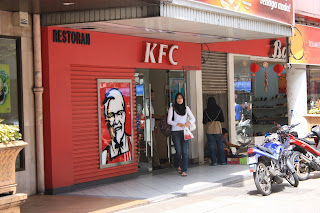First with the familiar. There is a funny mix of "Western" retailers in Thailand. Curiously, 7-11 stores are ubiquitous. Every neighbourhood and small town was apparently build around an orange, green, &blue striped and phosphorescently-lit anchor with great hours, exorbitant prices, and unmotivated employees. Slurpees uber alles.
There is a general lack of McDonalds, enough that it was notable when we saw one. But the marketing force of McDonalds is obviously respected:

Although it was common in Thailand, I was not prepared for the total market saturation enjoyed by Colonel in Malaysia. Malays are rarely outside of the reach of his benevolent gaze:
And of course, Southeast Asians, like the rest of the world's free citizens, are never far away from a frosty can of the Universal Solvent:

The worst ravages of Big Box retailing do not appear to have yet mortally injured the mom-and-pop operation in Thailand. There are some multi-acre stores out around the edge of major towns ("Big C", a division of the French company Groupe Casino and "Tesco", a division of the British Tesco Lotus), but the Big W isn't here yet. The dominant form of retail we observed were small, street-side (or commonly middle-of-the-street) family-run, businesses.
And Amway.

Which brings us the the subject of Public Markets. We visited many of them. Remember, "modern" Malaysia was founded as a European stronghold to control trade through the Straits of Malacca, which for you Geographically-challenged, is the shortest water route linking China and the Spice Islands to India, the Arabic world, and Europe beyond. Thailand's old capital of Chiang Mai was just a river crossing on a broad, fertile plain on the Mongol trade routes between the Ganges and China. In several cities on our travels, there were markets that had been there for several hundred years, at times more than a millennium!

What does a thousand years of tradition have on 60 years of post-war invisible hand and globalization? Not much apparently. In Bangkok we visited the sidewalk stalls lining miles of the Sukhumvit and the Chatuchack market; in Chiang Mai we toured the Night Bazaar in the Islamic section and the food market near the Chinese Gate; in Malayisa we saw the Tax Haven of Kuah on Langkawi, and the gargantuan yet claustrophobic Chinatown market in Kuala Lumpur. In the end, they were all depressingly the same.

Anything unique or interesting that may have existed in any of them has been replaced by endless rows of baseball caps emblazoned with Harley Davidson and Callaway Golf logos, Nike Swooshes, handbags, watches and belts carrying the names of an unlikely array of European designers, and several orders of magnitude more Ray Ban sunglasses than Ray Ban has ever produced. I can't help but feel something has been lost in this.

Which raised the question of why? Who the hell is buying all these fake Gucci handbags? Surely they cannot all be sold. Have all these merchants invested their live savings into crappy knock-off consumer goods? Is there some sort of second-level MLM scam going on? Is this like SPAM, where the only money being made is the people making the handbags and selling them to these stall merchants under promise of unlikely profit (considering there are another 47 booths within a hundred-foot radius selling the same crappy knock-offs)? Is this what the race to the bottom looks like? In this environment Amway starts to look pretty good.
Any fans of the Hitchhikers Guide to the Galaxy will recognize this as harbinger of the "Shoe Event Horizon" - The point every society reaches where the production of completely useless products (i.e: stiletto heels, "Texas Kicks Ass" belt buckles, Chevrolets) becomes so profitable, that is becomes economically impossible for any responsible corporation to to produce anything useful (i.e: penicillin, affordable housing, food).
Still, Tig picked up a nice pair of "Ray Ban"s.












































